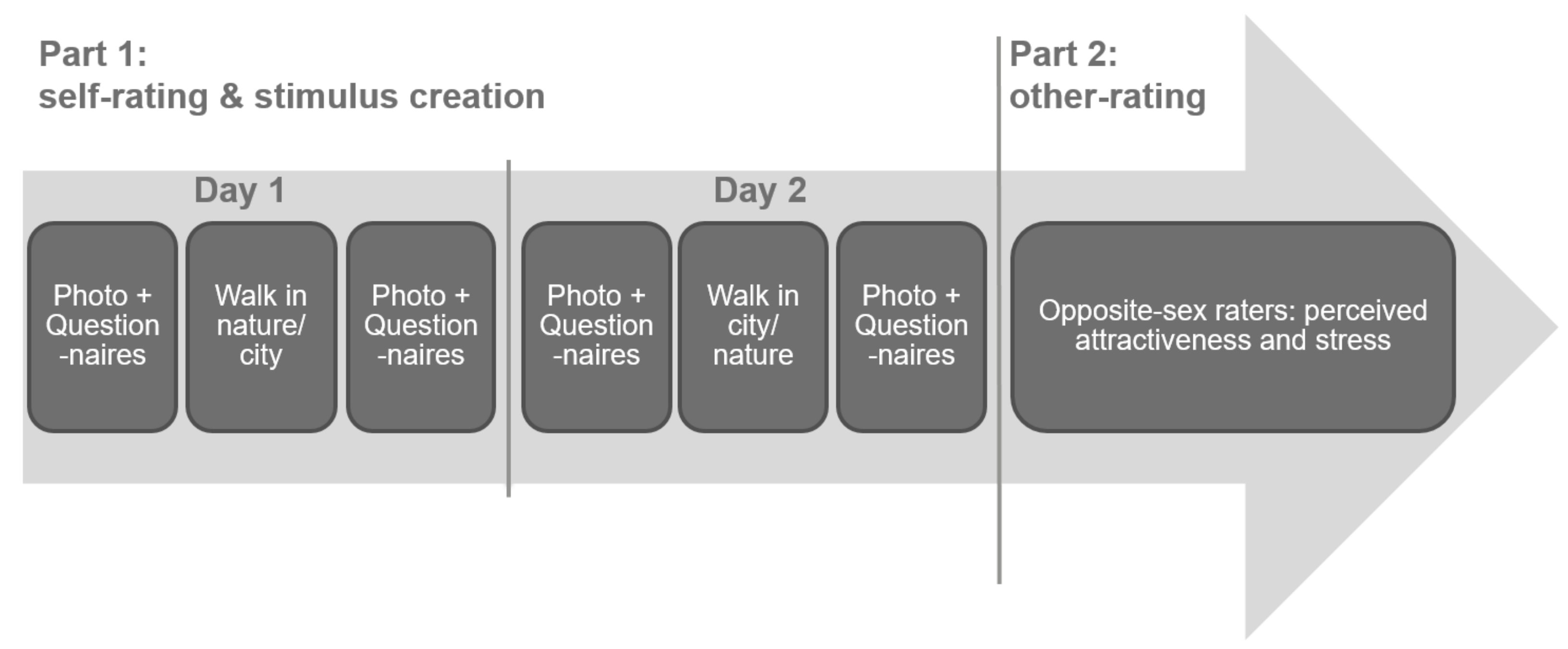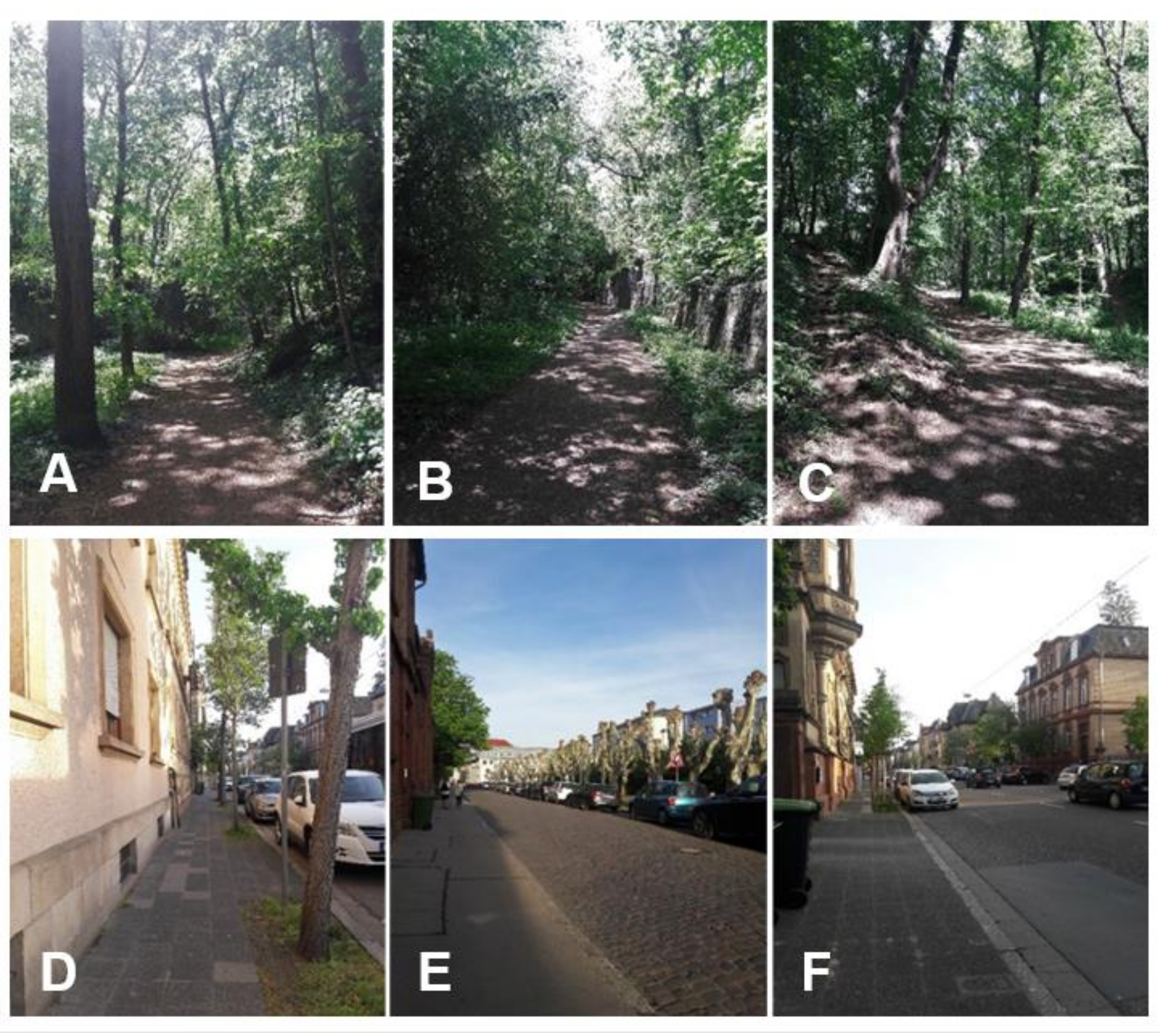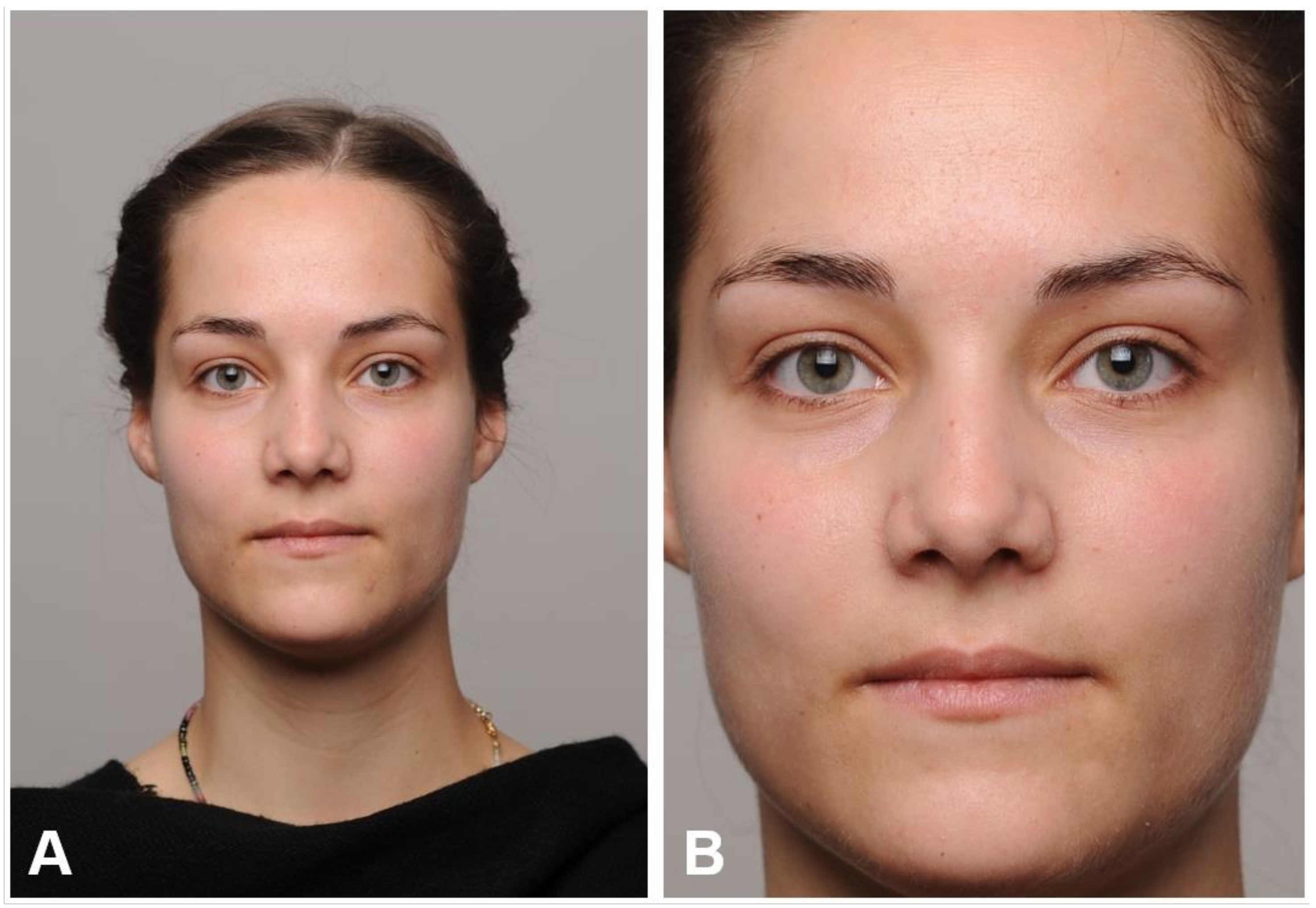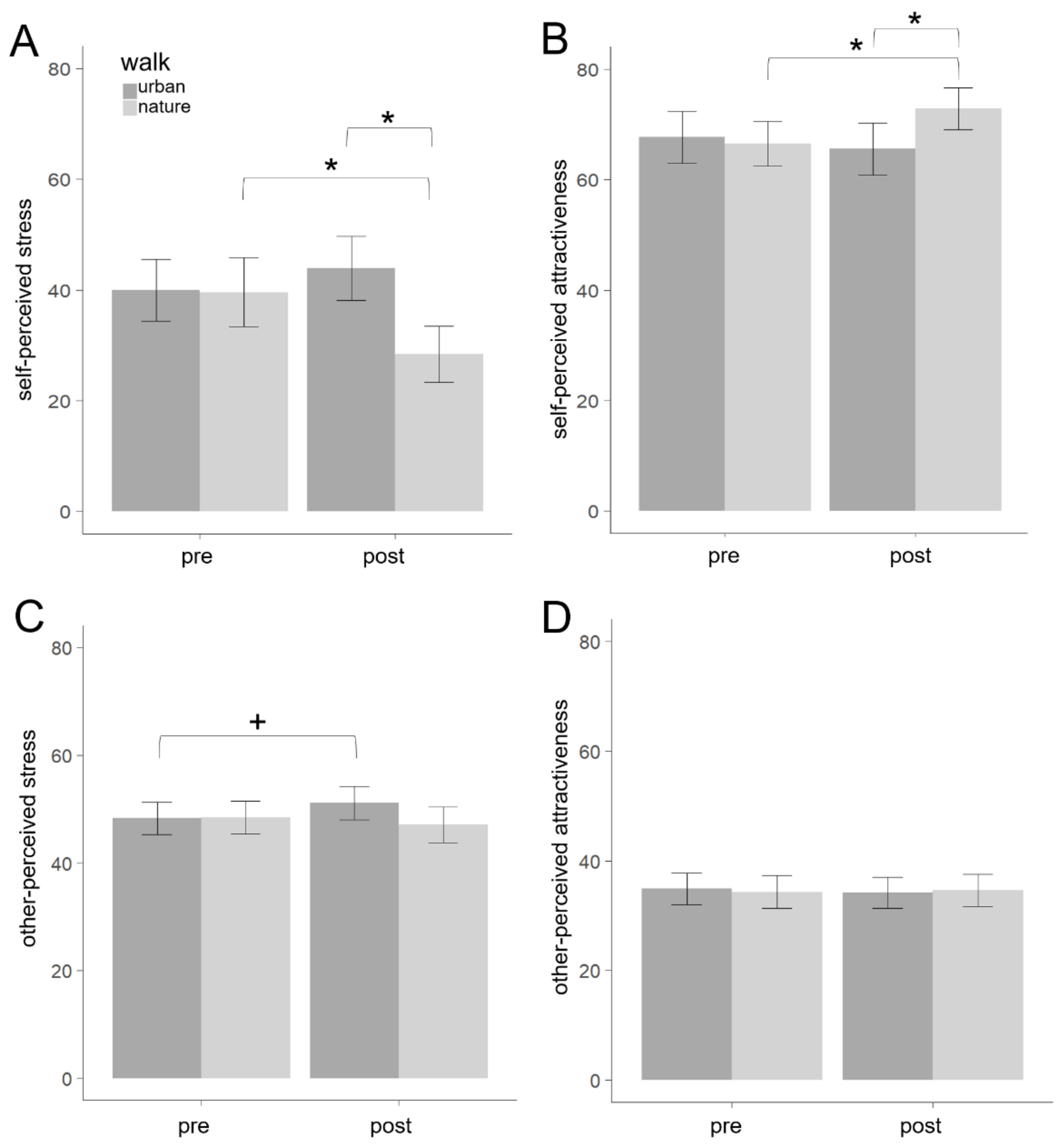Feeling Stressed and Ugly? Leave the City and Visit Nature! An Experiment on Self- and Other-Perceived Stress and Attractiveness Levels
Abstract
1. Introduction
2. Materials and Methods
2.1. Participants
2.1.1. Walkers
2.1.2. Raters
2.2. Procedure and Measures
2.3. Walks
2.4. Photographs
2.5. Data Analyses
3. Results
3.1. Self-Reported Measures by the Walkers
3.2. Other-Rated Stress and Attractiveness
4. Discussion
5. Relevance
6. Conclusions
Supplementary Materials
Author Contributions
Funding
Acknowledgments
Conflicts of Interest
References
- Aspinall, P.; Mavros, P.; Coyne, R.; Roe, J. The urban brain: Analysing outdoor physical activity with mobile EEG. Br. J. Sports Med. 2015, 49, 272–276. [Google Scholar] [CrossRef] [PubMed]
- Berman, M.G.; Jonides, J.; Kaplan, S. The Cognitive Benefits of Interacting with Nature. Psychol. Sci. 2008, 19, 1207–1212. [Google Scholar] [CrossRef] [PubMed]
- Marselle, M.R.; Irvine, K.N.; Warber, S.L. Examining Group Walks in Nature and Multiple Aspects of Well-Being: A Large-Scale Study. Ecopsychology 2014, 6, 134–147. [Google Scholar] [CrossRef]
- Menardo, E.; Brondino, M.; Hall, R.; Pasini, M. Restorativeness in Natural and Urban Environments: A Meta-Analysis. Psychol. Rep. 2019, 003329411988406. [Google Scholar] [CrossRef] [PubMed]
- Stevenson, M.P.; Schilhab, T.; Bentsen, P. Attention Restoration Theory II: A systematic review to clarify attention processes affected by exposure to natural environments. J. Toxicol. Environ. Health Part B 2018, 21, 227–268. [Google Scholar] [CrossRef]
- Swami, V.; Barron, D.; Furnham, A. Exposure to natural environments, and photographs of natural environments, promotes more positive body image. Body Image 2018, 24, 82–94. [Google Scholar] [CrossRef]
- Gidlow, C.J.; Jones, M.V.; Hurst, G.; Masterson, D.; Clark-Carter, D.; Tarvainen, M.P.; Smith, G.; Nieuwenhuijsen, M. Where to put your best foot forward: Psycho-physiological responses to walking in natural and urban environments. J. Environ. Psychol. 2016, 45, 22–29. [Google Scholar] [CrossRef]
- Kondo, M.C.; Jacoby, S.F.; South, E.C. Does spending time outdoors reduce stress? A review of real-time stress response to outdoor environments. Health Place 2018, 51, 136–150. [Google Scholar] [CrossRef]
- Lee, J.; Park, B.-J.; Tsunetsugu, Y.; Ohira, T.; Kagawa, T.; Miyazaki, Y. Effect of forest bathing on physiological and psychological responses in young Japanese male subjects. Public Health 2011, 125, 93–100. [Google Scholar] [CrossRef]
- Mao, G.X.; Lan, X.G.; Cao, Y.B.; Chen, Z.M.; He, Z.H.; Lv, Y.D.; Wang, Y.Z.; Hu, X.L.; Wang, G.F.; Yan, J. Effects of Short-Term Forest Bathing on Human Health in a Broad-Leaved Evergreen Forest in Zhejiang Province, China. Biomed. Environ. Sci. 2012, 25, 317–324. [Google Scholar] [CrossRef]
- Mygind, L.; Kjeldsted, E.; Hartmeyer, R.; Mygind, E.; Stevenson, M.P.; Quintana, D.S.; Bentsen, P. Effects of Public Green Space on Acute Psychophysiological Stress Response: A Systematic Review and Meta-Analysis of the Experimental and Quasi-Experimental Evidence. Environ. Behav. 2019, 001391651987337. [Google Scholar] [CrossRef]
- Park, B.J.; Tsunetsugu, Y.; Kasetani, T.; Kagawa, T.; Miyazaki, Y. The physiological effects of Shinrin-yoku (taking in the forest atmosphere or forest bathing): Evidence from field experiments in 24 forests across Japan. Environ. Health Prev. Med. 2010, 15, 18. [Google Scholar] [CrossRef] [PubMed]
- Tsunetsugu, Y.; Park, B.-J.; Ishii, H.; Hirano, H.; Kagawa, T.; Miyazaki, Y. Physiological Effects of Shinrin-yoku (Taking in the Atmosphere of the Forest) in an Old-Growth Broadleaf Forest in Yamagata Prefecture, Japan. J. Physiol. Anthropol. 2007, 26, 135–142. [Google Scholar] [CrossRef] [PubMed]
- Swami, V.; Barron, D.; Weis, L.; Furnham, A. Bodies in nature: Associations between exposure to nature, connectedness to nature, and body image in U.S. adults. Body Image 2016, 18, 153–161. [Google Scholar] [CrossRef]
- Swami, V.; Pickering, M.; Barron, D.; Patel, S. The impact of exposure to films of natural and built environments on state body appreciation. Body Image 2018, 26, 70–73. [Google Scholar] [CrossRef]
- Ulrich, R.S. Natural Versus Urban Scenes: Some Psychophysiological Effects. Environ. Behav. 1981, 13, 523–556. [Google Scholar] [CrossRef]
- Ulrich, R.S. Aesthetic and affective response to natural environment. In Behavior and the Natural Environment; Plenum Press: New York, NY, USA, 1983. [Google Scholar]
- Kaplan, S. The restorative benefits of nature: Toward an integrative framework. J. Environ. Psychol. 1995, 15, 169–182. [Google Scholar] [CrossRef]
- Little, A.C.; McPherson, J.; Dennington, L.; Jones, B.C. Accuracy in assessment of self-reported stress and a measure of health from static facial information. Personal. Individ. Differ. 2011, 51, 693–698. [Google Scholar] [CrossRef]
- Daros, A.R.; Ruocco, A.C.; Rule, N.O. Identifying Mental Disorder from the Faces of Women with Borderline Personality Disorder. J. Nonverbal Behav. 2016, 40, 255–281. [Google Scholar] [CrossRef]
- Gangestad, S.W.; Merriman, L.A.; Emery Thompson, M. Men’s oxidative stress, fluctuating asymmetry and physical attractiveness. Anim. Behav. 2010, 80, 1005–1013. [Google Scholar] [CrossRef]
- Moore, F.R.; Coetzee, V.; Contreras-Garduno, J.; Debruine, L.M.; Kleisner, K.; Krams, I.; Marcinkowska, U.; Nord, A.; Perrett, D.I.; Rantala, M.J.; et al. Cross-cultural variation in women’s preferences for cues to sex- and stress-hormones in the male face. Biol. Lett. 2013, 9, 20130050. [Google Scholar] [CrossRef] [PubMed]
- Moore, F.R.; Cornwell, R.E.; Law Smith, M.J.; Al Dujaili, E.A.S.; Sharp, M.; Perrett, D.I. Evidence for the stress-linked immunocompetence handicap hypothesis in human male faces. Proc. R. Soc. B Biol. Sci. 2011, 278, 774–780. [Google Scholar] [CrossRef] [PubMed]
- Rantala, M.J.; Moore, F.R.; Skrinda, I.; Krama, T.; Kivleniece, I.; Kecko, S.; Krams, I. Evidence for the stress-linked immunocompetence handicap hypothesis in humans. Nat. Commun. 2012, 3, 694. [Google Scholar] [CrossRef]
- Han, C.; Hahn, A.C.; Fisher, C.I.; Debruine, L.M.; Jones, B.C. Women’s facial attractiveness is related to their body mass index but not their salivary cortisol. Am. J. Hum. Biol. 2016, 28, 352–355. [Google Scholar] [CrossRef] [PubMed]
- Kandrik, M.; Hahn, A.C.; Han, C.; Wincenciak, J.; Fisher, C.I.; DeBruine, L.M.; Jones, B.C. Does the Interaction Between Cortisol and Testosterone Predict Men’s Facial Attractiveness? Adapt. Hum. Behav. Physiol. 2017, 3, 275–281. [Google Scholar] [CrossRef]
- Kordsmeyer, T.L.; Lohöfener, M.; Penke, L. Male Facial Attractiveness, Dominance, and Health and the Interaction between Cortisol and Testosterone. Adapt. Hum. Behav. Physiol. 2019, 5, 1–12. [Google Scholar] [CrossRef]
- Fink, B.; Penton-Voak, I. Evolutionary Psychology of Facial Attractiveness. Curr. Dir. Psychol. Sci. 2002, 11, 154–158. [Google Scholar] [CrossRef]
- Foo, Y.Z.; Simmons, L.W.; Rhodes, G. Predictors of facial attractiveness and health in humans. Sci. Rep. 2017, 7. [Google Scholar] [CrossRef]
- Rhodes, G. The Evolutionary Psychology of Facial Beauty. Annu. Rev. Psychol. 2006, 57, 199–226. [Google Scholar] [CrossRef]
- Fink, B.; Grammer, K.; Matts, P.J. Visible skin color distribution plays a role in the perception of age, attractiveness, and health in female faces. Evol. Hum. Behav. 2006, 27, 433–442. [Google Scholar] [CrossRef]
- Matts, P.J.; Fink, B.; Grammer, K.; Burquest, M. Color homogeneity and visual perception of age, health, and attractiveness of female facial skin. J. Am. Acad. Dermatol. 2007, 57, 977–984. [Google Scholar] [CrossRef] [PubMed]
- Stephen, I.D.; Oldham, F.H.; Perrett, D.I.; Barton, R.A. Redness enhances perceived aggression, dominance and attractiveness in men’s faces. Evol. Psychol. 2012, 10, 562–572. [Google Scholar] [CrossRef] [PubMed]
- Stephen, I.D.; Scott, I.M.L.; Coetzee, V.; Pound, N.; Perrett, D.I.; Penton-Voak, I.S. Cross-cultural effects of color, but not morphological masculinity, on perceived attractiveness of men’s faces. Evol. Hum. Behav. 2012, 33, 260–267. [Google Scholar] [CrossRef]
- Lefebvre, M.-A.; Pham, D.-M.; Boussouira, B.; Qiu, H.; Ye, C.; Long, X.; Chen, R.; Gu, W.; Laurent, A.; Nguyen, Q.-L. Consequences of urban pollution upon skin status. A controlled study in Shanghai area. Int. J. Cosmet. Sci. 2016, 38, 217–223. [Google Scholar] [CrossRef] [PubMed]
- Stephen, I.D.; Coetzee, V.; Law Smith, M.; Perrett, D.I. Skin Blood Perfusion and Oxygenation Colour Affect Perceived Human Health. PLoS ONE 2009, 4, e5083. [Google Scholar] [CrossRef]
- Stephen, I.D.; Law Smith, M.J.; Stirrat, M.R.; Perrett, D.I. Facial Skin Coloration Affects Perceived Health of Human Faces. Int. J. Primatol. 2009, 30, 845–857. [Google Scholar] [CrossRef]
- Axelsson, J.; Sundelin, T.; Ingre, M.; Van Someren, E.J.W.; Olsson, A.; Lekander, M. Beauty sleep: Experimental study on the perceived health and attractiveness of sleep deprived people. BMJ 2010, 341, c6614. [Google Scholar] [CrossRef]
- Farage, M.A.; Osborn, T.W.; MacLean, A.B. Cognitive, sensory, and emotional changes associated with the menstrual cycle: A review. Arch. Gynecol. Obstet. 2008, 278, 299–307. [Google Scholar] [CrossRef]
- Raghunath, R.S.; Venables, Z.C.; Millington, G.W.M. The menstrual cycle and the skin. Clin. Exp. Dermatol. 2015, 40, 111–115. [Google Scholar] [CrossRef]
- Roberts, S.C.; Havlicek, J.; Flegr, J.; Hruskova, M.; Little, A.C.; Jones, B.C.; Perrett, D.I.; Petrie, M. Female facial attractiveness increases during the fertile phase of the menstrual cycle. Proc. R. Soc. Lond. Ser. B Biol. Sci. 2004, 271, S270–S272. [Google Scholar] [CrossRef]
- Röder, S.; Brewer, G.; Fink, B. Menstrual cycle shifts in women’s self-perception and motivation: A daily report method. Personal. Individ. Differ. 2009, 47, 616–619. [Google Scholar] [CrossRef]
- Leiner, D.J. SoSci Survey, version 3.1.06. Computer Software. Ludwig-Maximilians-University: Munich, Germany, 2019. Available online: https://www.soscisurvey.de (accessed on 17 November 2020).
- Steyer, R.; Schwenkmezger, P.; Notz, P.; Eid, M. Der Mehrdimensionale Befindlichkeitsfragebogen (MDBF). In Handanweisung [The Multidimensional Affect Rating Scale (MDBF). Manual]; Hogrefe: Göttingen, Germany, 1997. [Google Scholar]
- Ziesenitz, A.-K. Die Natur als Erholungs(t)raum: Ein Empirischer Vergleich von Virtueller und Physischer Natur. Ph.D. Thesis, University of Kassel, Kassel, Germany, 2009. [Google Scholar]
- Korpela, K.M.; Ylén, M.; Tyrväinen, L.; Silvennoinen, H. Determinants of restorative experiences in everyday favorite places. Health Place 2008, 14, 636–652. [Google Scholar] [CrossRef] [PubMed]
- Ohly, H.; White, M.P.; Wheeler, B.W.; Bethel, A.; Ukoumunne, O.C.; Nikolaou, V.; Garside, R. Attention Restoration Theory: A systematic review of the attention restoration potential of exposure to natural environments. J. Toxicol. Environ. Health Part B 2016, 19, 305–343. [Google Scholar] [CrossRef]
- Barr-Wilson, S.K.; Roberts, N.S. Adolescent Girls and Body Image: Influence of Outdoor Adventure on Healthy Living. J. Outdoor Recreat. Educ. Leadersh. 2016, 8, 148–164. [Google Scholar] [CrossRef]
- Mitten, D.; D’Amore, C. The nature of body image: The relationship between women’s body image and physical activity in natural environments. In Women and Nature? Beyond Dualism in Gender, Body, and Environment; Vakoch, D.A., Mickey, S., Eds.; Routledge: New York, NY, USA, 2017; pp. 96–116. [Google Scholar]
- Wei, H.; Hauer, R.J.; Chen, X.; He, X. Facial Expressions of Visitors in Forests along the Urbanization Gradient: What Can We Learn from Selfies on Social Networking Services? Forests 2019, 10, 1049. [Google Scholar] [CrossRef]
- Wei, H.; Ma, B.; Hauer, R.J.; Liu, C.; Chen, X.; He, X. Relationship between environmental factors and facial expressions of visitors during the urban forest experience. Urban For. Urban Green. 2020, 53, 126699. [Google Scholar] [CrossRef]
- Menzel, C.; Hayn-Leichsenring, G.U.; Langner, O.; Wiese, H.; Redies, C. Fourier power spectrum characteristics of face photographs: Attractiveness perception depends on low-level image properties. PLoS ONE 2015, 10, e0122801. [Google Scholar] [CrossRef]
- Russell, R. Sex, beauty, and the relative luminance of facial features. Perception 2003, 32, 1093–1107. [Google Scholar] [CrossRef]
- Golle, J.; Mast, F.W.; Lobmaier, J.S. Something to smile about: The interrelationship between attractiveness and emotional expression. Cogn. Emot. 2014, 28, 298–310. [Google Scholar] [CrossRef]
- Huang, C.-N.; Chen, C.-H.; Chung, H.-Y. The Review of Applications and Measurements in Facial Electromyography. J. Med Biol. Eng. 2005, 25, 15–20. [Google Scholar]
- Huang, H.-Y.; Hu, S. Sex Differences Found in Facial EMG Activity Provoked by Viewing Pleasant and Unpleasant Photographs. Percept. Motor Skills 2009, 109, 371–381. [Google Scholar] [CrossRef] [PubMed]
- Lerner, J.S.; Dahl, R.E.; Hariri, A.R.; Taylor, S.E. Facial Expressions of Emotion Reveal Neuroendocrine and Cardiovascular Stress Responses. Biol. Psychiatry 2007, 61, 253–260. [Google Scholar] [CrossRef] [PubMed]
- Reber, R.; Schwarz, N.; Winkielman, P. Processing fluency and aesthetic pleasure: Is beauty in the perceiver’s processing experience? Personal. Soc. Psychol. Rev. 2004, 8, 364–382. [Google Scholar] [CrossRef] [PubMed]
- Zellars, K.L.; Meurs, J.A.; Perrewé, P.L.; Kacmar, C.J.; Rossi, A.M. Reacting to and recovering from a stressful situation: The negative affectivity-physiological arousal relationship. J. Occup. Health Psychol. 2009, 14, 11–22. [Google Scholar] [CrossRef] [PubMed]
- Ali, M.U.; Liu, G.; Yousaf, B.; Ullah, H.; Abbas, Q.; Munir, M.A.M. A systematic review on global pollution status of particulate matter-associated potential toxic elements and health perspectives in urban environment. Environ. Geochem. Health 2019, 41, 1131–1162. [Google Scholar] [CrossRef] [PubMed]
- Benitez-Quiroz, C.F.; Srinivasan, R.; Martinez, A.M. Facial color is an efficient mechanism to visually transmit emotion. Proc. Natl. Acad. Sci. USA 2018, 201716084. [Google Scholar] [CrossRef]
- Kret, M.E. Emotional expressions beyond facial muscle actions. A call for studying autonomic signals and their impact on social perception. Front. Psychol. 2015, 6. [Google Scholar] [CrossRef]
- Menzel, C.; Redies, C.; Hayn-Leichsenring, G.U. Low-level image properties in facial expressions. Acta Psychol. 2018, 188, 74–83. [Google Scholar] [CrossRef]
- Murray, K.M.; Byrne, D.G.; Rieger, E. Investigating adolescent stress and body image. J. Adolesc. 2011, 34, 269–278. [Google Scholar] [CrossRef]
- Schmidt, S.; Petermann, F.; Brähler, E.; Stöbel-Richter, Y.; Koglin, U. Body image perception as a risk factor for chronic stress / Körperbildwahrnehmung als Risikofaktor für chronischen Stress. Kindh. Entwickl. 2012, 21, 227–237. [Google Scholar] [CrossRef]
- Buchanan, T.W.; Bagley, S.L.; Stansfield, R.B.; Preston, S.D. The empathic, physiological resonance of stress. Soc. Neurosci. 2012, 7, 191–201. [Google Scholar] [CrossRef] [PubMed]
- Oberle, E.; Schonert-Reichl, K.A. Stress contagion in the classroom? The link between classroom teacher burnout and morning cortisol in elementary school students. Soc. Sci. Med. 2016, 159, 30–37. [Google Scholar] [CrossRef] [PubMed]
- Whitehead, R.D.; Ozakinci, G.; Perrett, D.I. A randomized controlled trial of an appearance-based dietary intervention. Health Psychol. 2014, 33, 99–102. [Google Scholar] [CrossRef] [PubMed]




| Rater | Self | Other | ||||||
|---|---|---|---|---|---|---|---|---|
| Time | Pre | Post | Pre | Post | ||||
| Walk | Nature | Urban | Nature | Urban | Nature | Urban | Nature | Urban |
| aRRS | 27.95 ± 7.53 | 29.15 ± 5.19 | 30.10 ± 4.94 | 27.30 ± 6.69 | n.a. | n.a. | n.a. | n.a. |
| ROS | n.a. | n.a. | 25.35 ± 4.28 | 21.70 ± 4.33 | n.a. | n.a. | n.a. | n.a. |
| stress | 39.60 ± 27.93 | 39.95 ± 25.00 | 28.40 ± 22.75 | 43.90 ± 25.71 | 48.43 ± 3.07 | 48.30 ± 3.00 | 47.09 ± 3.33 | 51.11 ± 3.11 |
| attractiveness | 66.50 ± 18.20 | 67.70 ± 21.13 | 72.85 ± 17.13 | 65.55 ± 21.22 | 34.33 ± 2.99 | 34.90 ± 2.89 | 34.63 ± 2.94 | 34.19 ± 2.80 |
| correlation | −0.73 *** | −0.54 * | −0.34 | −0.18 | −0.63 ** | −0.61 ** | −0.60 ** | −0.17 |
Publisher’s Note: MDPI stays neutral with regard to jurisdictional claims in published maps and institutional affiliations. |
© 2020 by the authors. Licensee MDPI, Basel, Switzerland. This article is an open access article distributed under the terms and conditions of the Creative Commons Attribution (CC BY) license (http://creativecommons.org/licenses/by/4.0/).
Share and Cite
Menzel, C.; Dennenmoser, F.; Reese, G. Feeling Stressed and Ugly? Leave the City and Visit Nature! An Experiment on Self- and Other-Perceived Stress and Attractiveness Levels. Int. J. Environ. Res. Public Health 2020, 17, 8519. https://doi.org/10.3390/ijerph17228519
Menzel C, Dennenmoser F, Reese G. Feeling Stressed and Ugly? Leave the City and Visit Nature! An Experiment on Self- and Other-Perceived Stress and Attractiveness Levels. International Journal of Environmental Research and Public Health. 2020; 17(22):8519. https://doi.org/10.3390/ijerph17228519
Chicago/Turabian StyleMenzel, Claudia, Fiona Dennenmoser, and Gerhard Reese. 2020. "Feeling Stressed and Ugly? Leave the City and Visit Nature! An Experiment on Self- and Other-Perceived Stress and Attractiveness Levels" International Journal of Environmental Research and Public Health 17, no. 22: 8519. https://doi.org/10.3390/ijerph17228519
APA StyleMenzel, C., Dennenmoser, F., & Reese, G. (2020). Feeling Stressed and Ugly? Leave the City and Visit Nature! An Experiment on Self- and Other-Perceived Stress and Attractiveness Levels. International Journal of Environmental Research and Public Health, 17(22), 8519. https://doi.org/10.3390/ijerph17228519





